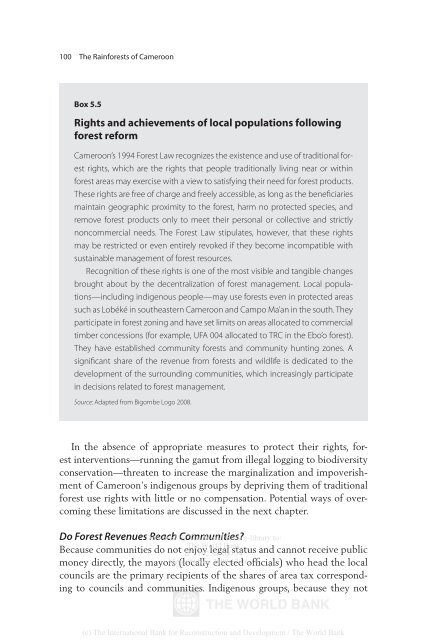The Rainforests of Cameroon - PROFOR
The Rainforests of Cameroon - PROFOR
The Rainforests of Cameroon - PROFOR
- No tags were found...
Create successful ePaper yourself
Turn your PDF publications into a flip-book with our unique Google optimized e-Paper software.
100 <strong>The</strong> <strong>Rainforests</strong> <strong>of</strong> <strong>Cameroon</strong>Box 5.5Rights and achievements <strong>of</strong> local populations followingforest reform<strong>Cameroon</strong>’s 1994 Forest Law recognizes the existence and use <strong>of</strong> traditional forestrights, which are the rights that people traditionally living near or withinforest areas may exercise with a view to satisfying their need for forest products.<strong>The</strong>se rights are free <strong>of</strong> charge and freely accessible, as long as the beneficiariesmaintain geographic proximity to the forest, harm no protected species, andremove forest products only to meet their personal or collective and strictlynoncommercial needs. <strong>The</strong> Forest Law stipulates, however, that these rightsmay be restricted or even entirely revoked if they become incompatible withsustainable management <strong>of</strong> forest resources.Recognition <strong>of</strong> these rights is one <strong>of</strong> the most visible and tangible changesbrought about by the decentralization <strong>of</strong> forest management. Local populations—includingindigenous people—may use forests even in protected areassuch as Lobéké in southeastern <strong>Cameroon</strong> and Campo Ma’an in the south. <strong>The</strong>yparticipate in forest zoning and have set limits on areas allocated to commercialtimber concessions (for example, UFA 004 allocated to TRC in the Ebo’o forest).<strong>The</strong>y have established community forests and community hunting zones. Asignificant share <strong>of</strong> the revenue from forests and wildlife is dedicated to thedevelopment <strong>of</strong> the surrounding communities, which increasingly participatein decisions related to forest management.Source: Adapted from Bigombe Logo 2008.In the absence <strong>of</strong> appropriate measures to protect their rights, forestinterventions—running the gamut from illegal logging to biodiversityconservation—threaten to increase the marginalization and impoverishment<strong>of</strong> <strong>Cameroon</strong>’s indigenous groups by depriving them <strong>of</strong> traditionalforest use rights with little or no compensation. Potential ways <strong>of</strong> overcomingthese limitations are discussed in the next chapter.Do Forest Revenues Delivered Reach by Communities?<strong>The</strong> World Bank e-library to:<strong>The</strong> World BankBecause communities do not enjoy IP : 192.86.100.34 legal status and cannot receive publicmoney directly, the mayors Mon, (locally 09 Nov 2009 elected 17:06:18 <strong>of</strong>ficials) who head the localcouncils are the primary recipients <strong>of</strong> the shares <strong>of</strong> area tax correspondingto councils and communities. Indigenous groups, because they not(c) <strong>The</strong> International Bank for Reconstruction and Development / <strong>The</strong> World Bank
















